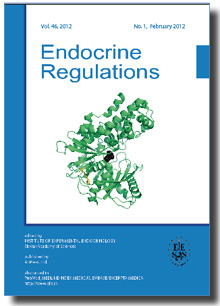Journal info
|
||
Select Journal
Journals
Bratislava Medical Journal Ekologia - Ecology Endocrine Regulations 2015 2014 2013 2012 2011 2010 2009 2008 2007 2006 2005 2004 2003 General Physiology and Biophysics Neoplasma Acta Virologica Studia Psychologica Cardiology Letters Psychológia a patopsych. dieťaťa Kovove Materialy-Metallic Materials Slovenská hudba 2025Webshop Cart
Endocrine Regulations Vol.43, No.2, p.65-73, 2009 |
||
| Title: ADRENAL PLASMA STEROID RELATIONS IN GLUCOCORTICOID-NAÏVE PREMENOPAUSAL RHEUMATOID ARTHRITIS PATIENTS DURING INSULIN-INDUCED HYPOGLYCEMIA TEST COMPARED TO MATCHED NORMAL CONTROL FEMALES | ||
| Author: R. Imrich, M. Vigas, J. Rovensky, J. C. Aldag, A. T. Masi | ||
| Abstract: Objective. Clinical and experimental data indicate the involvement of adrenal steroids in the complex of rheumatoid arthritis (RA) pathogenesis. A subtle adrenocortical hypocompetence has been suggested in a subset of glucocorticoid-naïve premenopausal females with RA. Methods. The interrelations among adrenal steroids: cortisol (CORT), 17α-hydroxyprogesterone (17-OHP), androstenedione (ASD), dehydroepiandrosterone (DHEA) and dehydroepiandrosterone sulphate (DHEAS) were evaluated in 15 glucocorticoid-naïve premenopausal females with RA and in 14 age- and body mass index- matched healthy females at basal and during insulin-induced hypoglycemia states. Spearman’s correlations were used to analyze baseline plasma concentrations as well as areas under response curves of these steroids levels as assayed during the basal and/or insulin-induced hypoglycemia status. Results. Six among 15 RA patients, but none of 14 controls had combined “lower” quartile range of basal cortisol (<431 nmol/l) and lower DHEAS (<2.79 μmol/l) levels, i.e., concentrations within the lowest quartiles of the control group (p=0.017). In all subjects combined, basal correlations were significantly positive between ASD and other steroids (CORT, 17OHP, DHEA, DHEAS). When patient and control groups were analyzed separately, the positive basal correlation between ASD and CORT was significant only in RA patients (p=0.030). In contrast, a positive basal correlation between ASD and DHEA was significant only in controls (p=0.004). When comparing the areas under response curves (AUCs), the correlation of ASD and CORT was significantly negative in RA (p=0.009), but positive in controls (RA vs control difference in Spearman’s correlations, p=0.002). The correlation between AUCs of ASD and DHEA was strongly positive in controls (p=0.006), but not in RA (RA vs. control difference p=0.044). Conclusions. The results suggest relative hypocompetence of adrenocortical function in premenopausal RA females. Different patterns of correlations of the adrenal steroids during basal vs. stimulatory testing suggested certain alterations in adrenal synthetic pathways or deficiencies in the dynamics of steroidogenesis in RA. |
||
| Keywords: Rheumatoid arthritis – Insulin – Hypoglycemia – Adrenal steroids – Premenopausal women | ||
| Year: 2009, Volume: 43, Issue: 2 | Page From: 65, Page To: 73 | |
| doi:10.4149/endo_2009_02_65 |
||
|
|
 download file download file |
|

